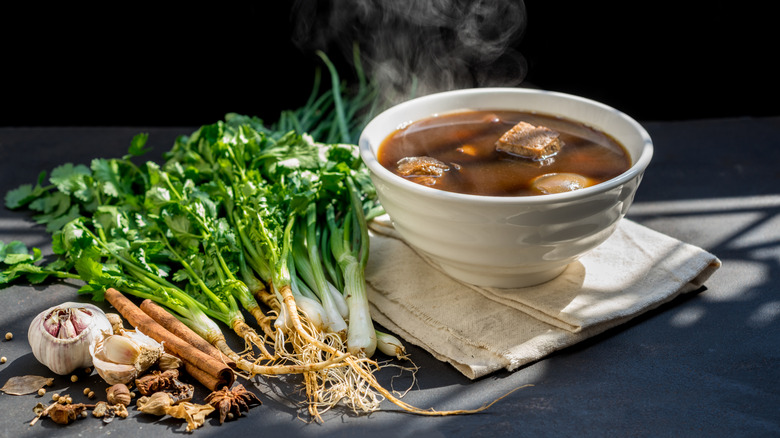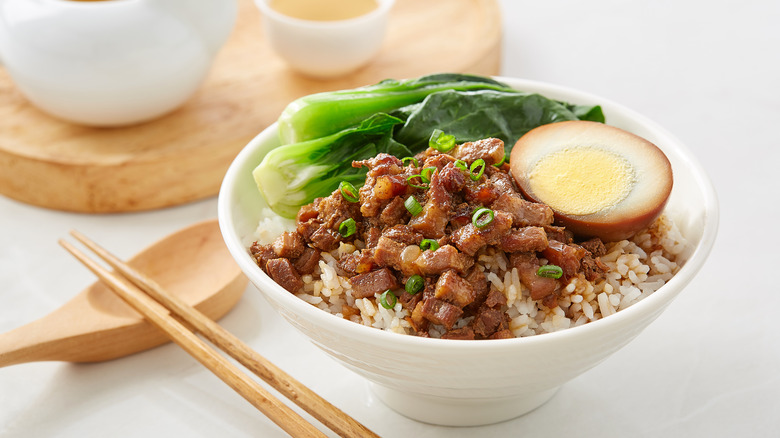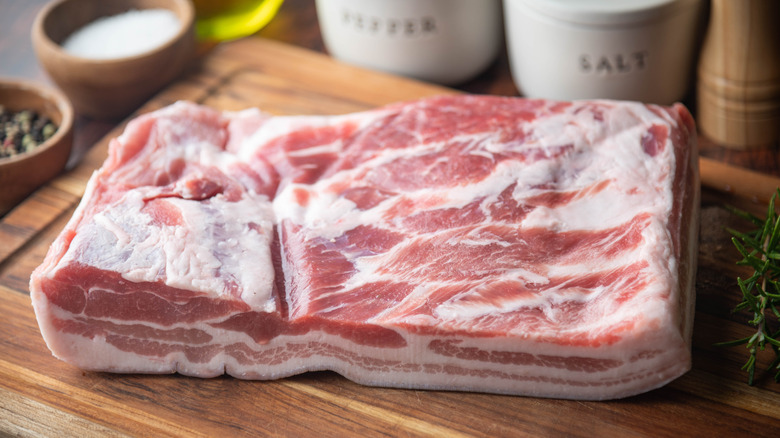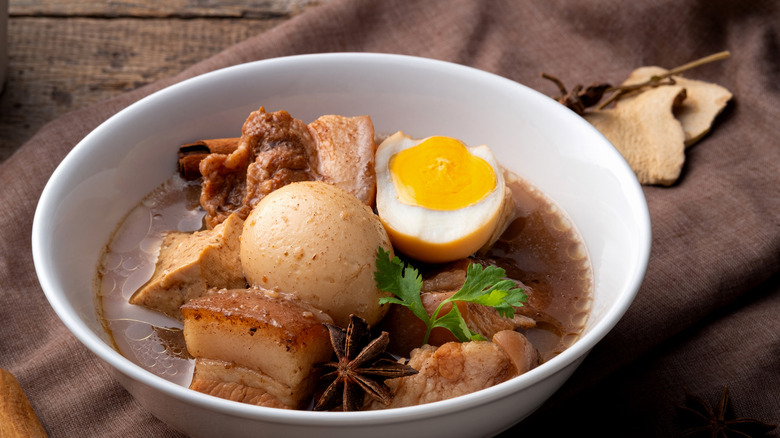Moo Palo: The Thai Pork Belly And Egg Stew That's A Culinary Staple
Fusion food can be a tough thing to nail down. It can be when one particular food is combined with another like the cronut or pumpple cake, but it can also be something far broader. As Smithsonian points out, it most often refers to a fusion of cultures rather than foods or preparation styles.
While it might seem like a modern idea, this concept has been around for as long as one people have encountered another, either in a hostile or cooperative way. It goes back at least to when Marco Polo learned how to make pasta from the Chinese, but swapping and adapting recipes is surely as old as cooking itself (via Cucina Toscana). In this way, foods can grow, adapt, and evolve within different cultures — though this sometimes fails us, such as when folks put ketchup in Pad Thai.
A successful example of fusion cuisine is the Thai dish known as moo palo. Thai Cookbook TV says that this common Thai food consists of pork belly braised in a fragrant and well-seasoned stew and served with boiled eggs. Much like the previously mentioned pasta, moo palo also comes from China but eventually made its way to Thailand, where it was embraced and adapted with local ingredients.
Moo Palo's Chinese origins
Many Thai stir fry dishes bear the mark of Chinese influence, according to The Atlantic. Though it's hard to pin down an individual dish's exact origins, people belonging to South Asian cultures haven't stopped trying. One curious Quora user sought to crowdsource some help by asking why so many similar pork and egg dishes have popped up in the region.
A very similar dish that serves pork belly and marinated egg over rice rather than in a stew is lu ro fan, known as gai fan in China, according to Red House Spice. The Woks of Life says that the origin of lu rou fan is a contentious issue between Taiwan and mainland China. So much so that government officials in Taipei handed out more than a thousand bowls to stir up popular sentiment among its citizens and cement the dish as a Taiwanese invention.
Thai Food Master says that moo palo was introduced to Thailand in the 19th century when Tae Chiew immigrants moved to the country. Since then, common Thai ingredients like palm sugar and Thai oyster sauce were incorporated into the dish to give it a unique flavor that stands apart from lu rou fan.
Moo Palo's key ingredients
The base of this dish is its flavorful braising mixture. Thai Cookbook TV says this usually consists of coriander, garlic, star anise, cinnamon, black pepper, and Sichuan pepper. According to Hot Thai Kitchen, these spices are combined with palm sugar to create a sweet and spicy broth that nicely complements the rich flavors of the meat. It's worth noting that this dish omits many of Thai cuisine's most common spices like galangal, makrut lime, Thai basil or tamarind, so if you're craving those quintessential flavors, you would be better off with something like tom yam pla.
The star protein in the dish is pork belly, which is the same cut of meat as bacon. Though most recipes aren't specific about whether or not the meat should be cured, Serious Eats recommends using pork belly that still has the skin on.
The last key ingredient is eggs. According to Hot Thai Kitchen, the eggs braised in the moo palo are first completely hard-boiled — to the point of being overcooked by most standards. If you prefer a softer egg, ensure you give them at least 30 minutes to rest in the stew so that they pick up the rich flavors of the broth.
How to make Moo Palo
Serious Eats recommends starting any batch of moo palo by browning the pork belly. Getting the fat layer nice and crispy will also render much of it down, which will make its way into the stew. Next, add palm sugar to the rendered fat and allow it to caramelize before adding in the ground spices and paste of aromatic ingredients. Then add the meat back into your pot, as well as water to create the stew.
They recommend letting the stew simmer for about an hour and 20 minutes before it is finished, though Thai Cookbook TV says that 45 minutes will suffice. Moo palo is typically made in a large pot over a stovetop, but Hot Thai Kitchen says you can prepare it in an instant pot as well.
This dish can easily be prepared ahead of time. In fact, Serious Eats claims that the flavor only improves as they mellow together, and the eggs have more time to spend in the broth without overcooking. Once it's finished, you can serve moo palo with a side of steamed jasmine rice, and other spicy dishes or sauces that will balance out its deep sweetness.



